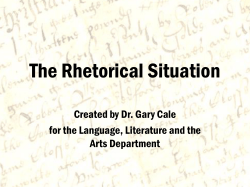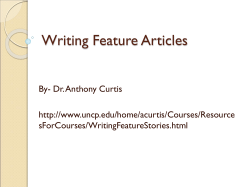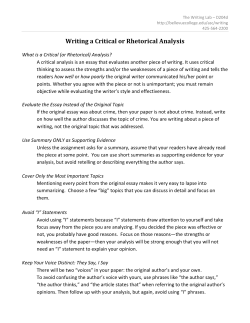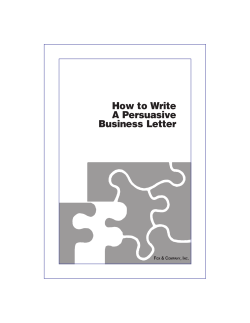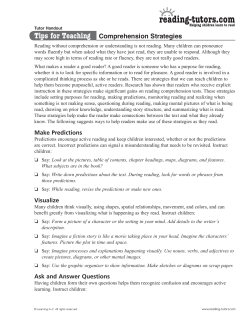
AP Language and Composition Summer Reading Assignment Dr. Lisa Wieland
AP Language and Composition Summer Reading Assignment Dr. Lisa Wieland First of all, WELCOME to AP English Language and Composition. I am looking forward to working with you next year. This will be a CHALLENGING class, but if you stick with me and do the work as assigned to the best of your ability, you should learn and develop tremendously. In the class, you’ll learn that EVERYTHING’S AN ARGUMENT! If you think about it, even poetry and fiction are persuasive in that they offer some kind of opinion. When school begins in the fall, we will look closely at writing by studying Rhetoric (the art of expression and the persuasive use of language) and reading classic and modern essays. To prepare for this, you are to read 2 books this summer and complete several assignments with them (the details of these assignments are below.) All work must be typed! Believe it or not, I expect you to have all this finished by the first day of school. All of it will be graded on thoroughness, insight, and clear, organized writing. These assignments will be worth a total of 225 points in the major category. (The rubric is later in this assignment.). If you have any questions or problems with the work, please feel free to call me (454-4022) or email me at lisa.wieland@ahsrockets.org. Now, I will be out of town a couple of times this summer, and I may not check my email EVERY day, but I will do my best to get in touch with you in a timely manner. Assignment #1: How to Mark a Book (essay) Read the attached (short) essay, “How to Mark a Book” by Mortimer Adler before you read anything else! I expect you to annotate everything you read this summer and will check your annotations of Nickel and Dimed and of the novel you read and will give you a 25 point grade on your annotations. Assignment #2: Junior Summer Reading (fiction) Choose 1 of the books from the list below. In order to do this assignment, you’ll need buy the book so you can write in it and/or take careful notes as you read. When we read fiction this year, we won’t be analyzing it quite in the way that you have before. Rather, we’ll be focusing on the writer’s purpose and how he or she uses rhetorical strategies (such as word choice, tone, style, etc) to Book List: achieve that purpose. Frankenstein—Mary Shelley The Picture of Dorian Grey—Oscar Wilde 1. Read the book carefully. As you read, take Sense and Sensibility—Jane Austen notes in the margins about important ideas, Brave New World—Aldous Huxley questions you have, etc. Alias Grace—Margaret Atwood 2. As you read, look for the author’s rhetorical 1984—George Orwell strategies.. Use the attached list of rhetorical The Prime of Miss Jean Brodie—Muriel Spark strategies to help you locate rhetorical I Capture the Castle by Dodie Smith strategies and mark and label passages that The Screwtape Letters by C. S. Lewis contain them. The Thirteenth Tale by Diane Setterfield 3. When you are finished reading, create a READER’S LOG with 20 entries from throughout the book. In this log, you’ll identify individual rhetorical strategies and analyze them. Each entry should include all 3 of the following parts: • Completely quoted passage from the book that illustrates a rhetorical strategy and correct identification of the strategy exemplified by the quote. • 2-3 sententence explanation of HOW the passage is an example of the strategy (what about the wording or structure makes the passage a metaphor, asyndeton, allusion, vernacular, etc). • Explain WHY this example of a rhetorical strategy helps the writer develop his or her theme (for example, does it create a feeling, image or relationship for the reader, and how does that help the argument or tone? How is it persuasive?) NOTE: The reader’s log should contain a variety of strategies, not just the same few over and over! Here’s a sample log entry from Walden to get you started: “I wanted to live deep and suck out all the marrow of life, to live so sturdily and Spartanlike as to put to rout all that was not life, to cut a broad swath and shave close, to drive life into a corner, and reduce it to its lowest terms. . .” This quote is an example of ASYNDETON ( which is the elimination of conjunctions in a list). I know this is asyndeton because he says, “to live. . . to cut . . . to drive”. The use of asyndeton makes all the items in the series have equal value and emphasizes their importance. Throeau’s use of asyndeton in the passage helps him to present his major themes of living simply so that he can enjoy life to the fullest. Assignment #3: Nickel and Dimed by Barbara Ehrenreich 1. Buy this book. Read it actively (with a highlighter and pencil by your side so you can mark it as you read). 2. Read carefully the following definitions of PATHOS, LOGOS, and ETHOS (how the writer goes about making his or her case to her audience) 3. TYPE 3 one-page analyses of how Ehrenreich uses these three appeals (pathos, logos, and ethos) in her book. Each one-page assignment should address only one term. You are NOT summarizing her argument, but rather ANALYZING her use of ethos, pathos, or logos to advance the argument(s) in her book. Please note: Use quotes sparingly to supplement your analyses (direct quotes should constitute no more than 10% of each one-page essay). Possible questions to address: By using this type of appeal (logos, pathos, or ethos), is Ehrenreich’s argument made stronger/weaker? How is it improved? How is it not improved? Why does she use this type of appeal? Does the argument lend itself toward it? Rhetoric—1) the art of finding and analyzing all the choices involving language that a writer, speaker, reader, or listeners might make in a situation so that the text becomes meaningful, purposeful, and effective for readers or listeners; 2) The specific features of texts, written or spoken, that cause them to be meaningful, purposeful, and effective for readers and listeners in a given situation. In order to make the rhetorical relationship—speakers to hearers, hearers to subjects, speakers to subjects—most successful, writers use what Aristotle and his descendants called the appeals: logos, ethos, and pathos. They appeal to a reader’s sense of logos when they offer clear, reasonable premises and proofs, when they develop ideas with appropriate details, and when they make sure readers can follow the progression of ideas. The logical thinking that informs speakers’ decisions and readers’ responses forms a large part of the kind of writing students accomplish in school. Writers use ethos when they demonstrate that they are credible, good-willed, and knowledgeable about their subjects, and when they connect their thinking to readers’ own ethical or moral beliefs. When writers draw on the emotions and interests of readers, and highlight them, they use pathos, the most powerful appeal and the most immediate—hence its dominance in advertisements. Students foreground this appeal when they use personal stories or observations, sometimes even within the context of analytical writing, where it can work dramatically well to provoke readers’ sympathetic reaction. Figurative language is often used by writers to heighten the emotional connections readers make to the subject. Emily Dickinson’s poem that begins with the metaphor “My life had stood—a loaded gun,” for example, provokes readers’ reactions of fear or dread as they begin to read. Logos: appeals to reader’s logic/reason Pathos: appeals to reader’s emotions and interests Ethos: appeals based on writer’s credibility, goodwill, “moral” or ethical standing, and knowledge. Assignment #4: OP/ED Articles: To begin to gather ideas and support for the arguments you will be asked to make, you need to read The New York Times, The New Yorker, The New Republic, Harper’s, The Wall Street Journal, The Washington Post, The Economist, Time, Newsweek, or other newspapers and newsmagazines OF SIMILAR QUALITY. (Note: You can access the New York Times online; in their Sunday edition, they have a great section called the “Week in Review” which gives a wonderful overview of the main events and arguments of the week.) 1. From your reading, you will select 5 OPINION articles throughout the summer. I recommend that you shoot for 2 in June, 2 in July, and 1 in August so that your choices reflect variety and prove to your teacher (who I’m sure you’re trying to impress ) that you didn’t wait until the last minute to get started on your summer work. 2. For each of these pieces, you need to cut out or copy the article; 3. attach a half-sheet of paper on which you have typed the correct MLA citation for the article ; 4. write a paragraph-length response focusing on whether you think the writer used rhetorical strategies effectively to make his/her argument. Great columnists to look for: David Brooks, Maureen Dowd, Bob Herbert, Nicholas D. Kristof, Paul Krugman, Frank Rich, Leonard Pitts, George Will, Gail Collins, Kathleen Parker. Note: I will recognize and appreciate GOOD EFFORT here, and I will also recognize last-minute weekend products. Take your time and start early! This is worth a lot of points, and you want to start off the year strong! SO, HOW WILL THIS BE GRADED? Both books (Nickel and Dimed and the novel you choose) are annotated thoughtfully and thoroughly /25 Reader’s Log for fiction /75 Nickel and Dimed essays (20 points each) /60 5 columns (8 points each) /40 /200 points In the major category: Here’s a list of Rhetorical Strategies to look for. (Note: this is a very incomplete list, but limit yourself to these terms for now. We’ll learn LOTS more next year ) Allusion—reference to something literary, mythological, or historical that the author assumes the reader will recognize Anaphora—repetition of the same word or group of words at the beginning of successive clauses (Ex: “In books I find the dead as if they were alive; in books I forsee things to come; in books carlike affairs are set forth; from books come forth the laws of peace.”) Antithesis—a statement in which two opposing ideas are balanced Asyndeton—a construction in which elements are presented in a series without conjunctions (“They spent the day wondering, searching, thinking, understanding.”) Cliché—an expression that has been overused to the extent that its freshness has worn off (“the time of my life,” “at the drop of a hat,” etc) Diction—the word choices made by a writer (diction can be described as: formal, semi-formal, ornate, informal, technical, etc.) Hyperbole—intentional exaggeration to create an effect. Imagery—the use of figures of speech to create vivid images that appeal to one of the senses. Inverted syntax—a sentence constructed so that the predicate comes before the subject (ex: In the woods I am walking.) Irony—the use of words to convey the opposite of their literal meaning; or, incongruity between what is expected and what acutally occurs (situational, verbal, dramatic) Litotes—a type of understatement in which an idea is expressed by negating its opposite (describing a particularly horrific scene by saying, “It was not a pretty picture.”) Metaphor—a direct comparison of two different things. Metonymy—substituting the name of one object for another object closely associated with it (“The pen [writing] is mightier than the sword [war/fighting]” .) Paradox—an apparently contradictory statement that actually contains some truth (“Whoever loses his life, shall find it.”) Parallelism—the use of corresponding grammatical or syntactical forms Parenthesis—comment that interrupts the immediate subject, often to qualify or explain. Personification—endowing non-human objects or creatures with human qualities or characteristics Polysyndeton—the use, for rhetorical effect, of more conjunctions than is necessary or natural (“And to set forth the right standard, and to train according to it, and to help forward all students towards it according to their various capacities, this I conceive to be the business of a University.”) Rhetorical question—a question asked merely for rhetorical effect and not requiring an answer. Satire—the use of humor to emphasize human weaknesses or imperfections in socal institutions Tone—the attitude of a writer, usually implied, toward the subject or audience Vernacular—the everyday speech of a particular country or region, includes slang Logos –see definition previous page Pathos–see definition previous page Ethos–see definition previous page
© Copyright 2025







